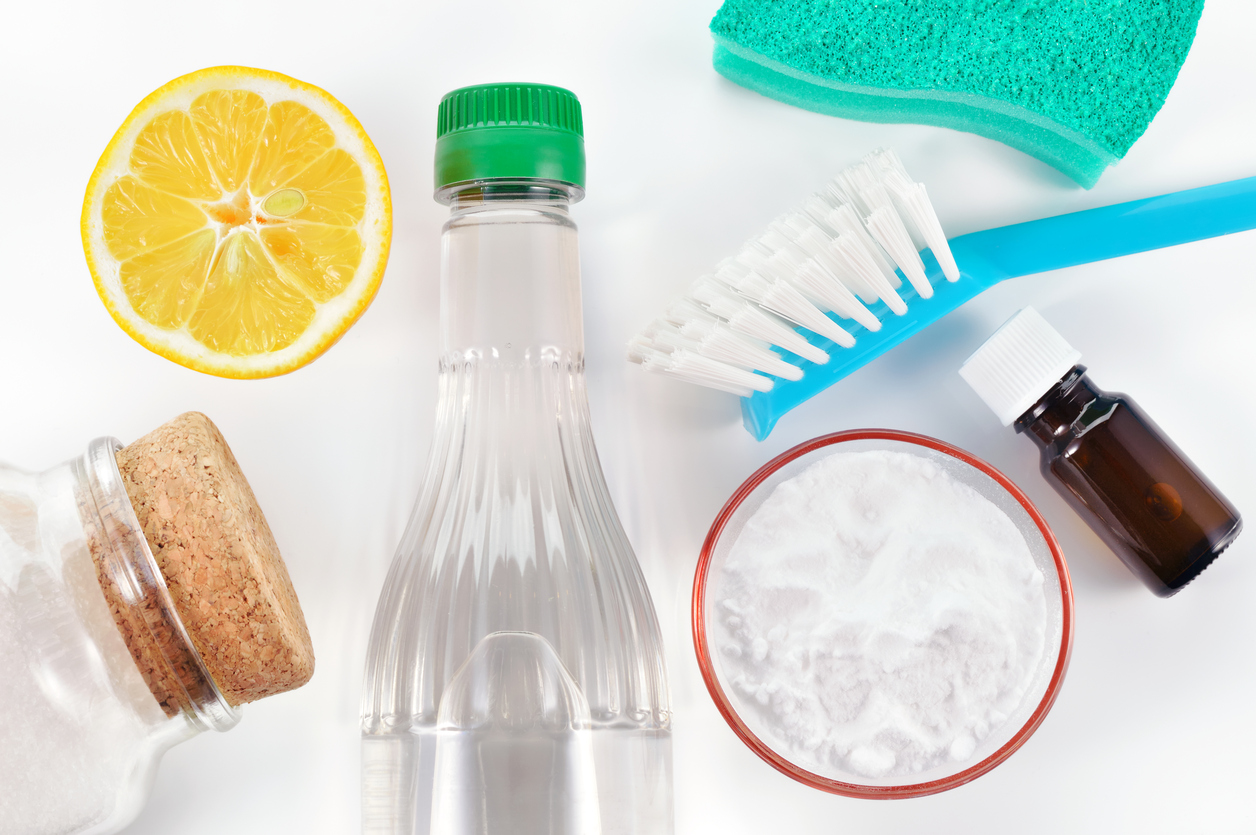
10 Jul Are your household cleaning products posing a risk to you and your baby?
If you are an expectant mother, chances are you are busy with a million different things trying to prepare for the arrival of your baby, cleaning being one of them. We know that some cleaning supplies contain “harsh chemicals,” but what does that mean? If I asked you what are in your cleaning products, would you know? Most likely they contain quaternary ammonium compounds or QACs.
QACs are a class of chemicals that are used for their antimicrobial and antistatic properties.1 These chemicals can be found in common cleaners, disinfectants, shampoos, conditioners, and laundry products. Two common quaternary ammonium compounds, alkyldimethylbenzyl ammonium chloride (ADBAC) and didecyldimethyl ammonium chloride (DDAC), are often combined in common cleaners and disinfectants.1 When together, they can work synergistically to cause greater toxicity.4,5,6
Products containing QACs has increased significantly over time, leading to an even greater increase in human exposure.This increased usage has changed the quantity and quality of human exposure.7
So what does this mean for mama and baby? ADBAC and DDAC have previously been proven to decrease reproductive fertility in female and male mice. The present study conducted by Virginia Tech University sought to evaluate developmental toxicity. The study illustrated that with ambient exposure to ADBAC and DDAC, there was an increase in fetal neural tube defects (NTD) in both rats and mice. Developmental toxicity caused by ADBAC and DDAC lead to NTDs in early gestation and decreased survivability in late gestation.1
The study also found these interestingly notable results:
- The NTDs caused by ADBAC and DDAC were observed two generations after cesation of exposure
Ambient exposure from disinfectants containing ADBAC and DDAC were more influential on NTDs than oral dosing* - The Environmental Protection Agency’s risk assessment for ADBAC and DDAC determined that inhalation exposure carries a greater risk to human health than oral routes of exposure8
- Male exposure alone was enough to cause NTDs in offspring
- It is important to consider both maternal and paternal exposures when evaluating developmental outcomes
Each year in the United States, 150,000 to 200,000 babies are born with a structural birth defect.1 NTDs are the second most prevalent malformation after cardiac defects.3 This study illustrates that birth defects may be induced at relatively low, environmentally relevant doses, such as when using cleaning products containing QACs. With the widespread use of ADBAC and DDAC, the U.S. population is being regularly and repeatedly being exposed to QAC containing products.1
So what steps should you be taking to help ensure your baby is born happy and healthy? To start, be aware of the products you are using in your household. This may be especially relevant during preconception, as neural tube closure occurs in the first 2-8 weeks of pregnancy. Try to opt for natural cleaners without QACs or other dangerous compounds such as triclosan and chlorine. Below are some tips to help you when shopping for nontoxic cleaners and options for making your own.
Shopping Tips
Non-toxic Solutions:
- Look for “green” and non-toxic cleaners that don’t contain chlorine, alchohols, triclosan, triclocarbon, lye, glycol ethers, or ammonia.
- Choose ones that say “petroleum-free,” “90% biodegradable in 3 days,” or “phosphate-free.”
- Choose safer products that say “petroleum-free,” “biodegradable,” “phosphate-free,” “VOC-free,” and “solvent-free.”9
- Another great resource for a guide for finding safe cleaning products can be found here: http://
www.ewg.org/guides/cleaners/content/top_products
DIY Cleaners:
You can also make your our DIY cleaners using safe ingredients such as baking soda, white vinegar, cornstarch, and essenced oils. Many different cleaning concoctions can be found at: http://eartheasy.com/live_nontoxic_solutions.htm
Lastly, another great resource for DIY Cleaners can be found here:
REFERENCES: 1. Terry C. Hrubec, Vanessa E. Melin, Caroline S. Shea, Elizabeth E. Ferguson, Craig Garofola, Claire M. Repine, Tyler W. Chapman, Hiral R. Patel, Reza M. Razvi, Jesse E. Sugrue, Haritha Potineni, Geraldine Magnin-Bissel, Patricia A. Hunt. Ambient and dosed exposure to quaternary ammonium disinfectants causes neural tube defects in rodents. Birth Defects Research, 2017; DOI: 10.1002/bdr2.1064 2. Virginia Tech. “Common household chemicals lead to birth defects in mice, research finds.” ScienceDaily. ScienceDaily, 17 June 2017. <www.sciencedaily.com/releases/2017/06/170617073635.htm>. 3. Christianson A, Howson CP, Modell B. 2006. March of Dimes global report, executive summary. White Plains, NY: March of Dimes Foundation 4. Hermens J, Leeuwangh P, Musch A. 1985. Joint toxicity of mixtures of groups of organic aquatic pollutants to the guppy (Poecilia reticulata). Ecotoxicol Environ Saf 9:321–326. 5. Faust M, Altenburger R, Backhaus T, et al. 2003. Joint algal toxicity of 16 dissimilarly acting chemicals is predictable by the concept of independent action. Aquat Toxicol 63:43–63. 6. Narotsky MG, Best DS, McDonald A, et al. 2011. Pregnancy loss and eye malformations in offspring of F344 rats following gestational exposure to mixtures of regulated trihalomethanes and haloacetic acids. Reprod Toxicol 31:59– 65. 7. PubChem Database, NIH, National Center for Biotechnology Information. Available at: https:// pubchem.ncbi.nlm.nih.gov/. Accessed May 10, 2017. 8. EPA, Office of Prevention, Pesticides and Toxic Substances, US EPA. Reregistration eligibility decision for alkyl dimethyl benzyl ammonium chloride (ADBAC). EPA739-R-06-009, August 2006. 9. http://www.webmd.com/a-to-z-guides/features/best-nontoxic-ways-to-clean-home#2

Sorry, the comment form is closed at this time.